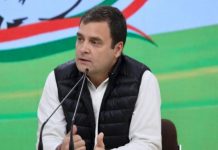
The Vishwa Hindu Parishad’s (VHP) miserable attempt to mount an ill-disguised religio-political procession from 25 August in the temple town of Ayodhya has left everyone astounded. After failing repeatedly in over a decade to reignite the sectarian fire, did the self-acclaimed torchbearers of the Hindu faith really think they had traction with the masses?
“The VHP is a highly discredited organisation with no support among the common people as well as Ayodhya’s religious leaders,” says Mahant Gyan Das, the chief priest of the centuries’ old Hanuman Garhi temple and a formidable opponent of the VHP-led bid to build a Ram temple on the spot where once the 16th-century Babri Masjid stood. Adds Yugal Kishore Shastri, chief priest of another temple nearby and an unsparing critic of the VHP: “Divided along caste lines, the sadhus and saints are aligned with different political parties. Hardly any are with the VHP.” Which means hardly any are with the Bharatiya Janata Party (BJP), the political arm of the self-styled Hindu supremacist Rashtriya Swayamsevak Sangh (RSS) of which the VHP is the religious wing.
Indeed, barring the heydays of the VHP-BJP-RSS movement of the late 1980s that culminated in the demolition of the Babri Masjid on 6 December 1992, the VHP has never succeeded in rousing the hundreds of millions of India’s Hindus. The VHP’s goals to “recover” various other mosques, which the Hindu right claims Muslim “invaders” of the past built after demolishing ancient Hindu temples, never quite gained popular support.
For decades the VHP had been in the vanguard of the RSS’s bid to expand among the poorer tribal and backward communities, especially in Orissa, Madhya Pradesh, Gujarat, Rajasthan, Karnataka, Jharkhand and Chhattisgarh. Later, the bogey of Hindus converting to Christianity due to missionary work became its bugbear. Nearly all the violence against Christians and missionaries in the last two decades in these states can be put down to the VHP and its thuggish offshoot, the Bajrang Dal.
The VHP was seeded at a meeting of 60-odd religious heads and Hindu-minded activists that RSS stalwart MS Golwalkar called at Mumbai in 1964 after Prime Minister Jawaharlal Nehru decided to create the states of Punjab with a Sikh majority on the border with Pakistan, and Nagaland with a Christian majority in the northeast on the border with Burma. Thus, the VHP began with the war cry of “Hinduism in danger”.
But the VHP would not develop its fiery and militant approach to “safeguard” the Hindu religion until the 80s. According to historian Manjari Katju of the University of Hyderabad, the VHP could not initially echo the shrill sectarian pitch of the RSS as many non-RSS stalwarts adorned its top ranks, such as Sushil Muni of the Jain community and Karan Singh, a scion of Jammu and Kashmir’s former ruling dynasty.
“[T]he early VHP… was not conceived as a front-ranking, overt and loud political outfit, but as a socio-religious organisation that had to calmly feed into the RSS’s agenda of exclusive Hindu nationalism,” Katju wrote in her seminal book, Vishwa Hindu Parishad and Indian Politics in 2004. “Evidence suggests that it did not have a clear-cut plan to regenerate the Hindus as political community.”
The VHP’s fiery militancy first emerged when hundreds of Dalits embraced Islam in 1981 in Tamil Nadu’s Theni district. The VHP launched a nationwide campaign to “save” the Hindu religion that it claimed faced a serious threat from Islam. Its next milestone would be the dispute over the Babri mosque, which both Hindus and Muslims claimed as theirs but neither had access to. The issue jumped to the centre stage of national politics in 1986 after then prime minister Rajiv Gandhi, in an ill-advised move, allowed the doors of the mosque to be unlocked for Hindu devotees.
With some local “saints” and religious heads, the VHP quickly revived its dormant movement to wrest control of the disputed structure. It helped that the outfit had developed an organisational structure in the preceding four years. An assembly of religious heads acted as a central authority, supported by advisory committees of representatives of various Hindu sects. Today, the VHP boasts over 6,700 branches across India. Over 3,000 functionaries work full-time. It claims to have three million primary members around the country.
But the VHP’s glory days are long gone. Time was firebrand leaders such as Ashok Singhal and Praveen Togadia commanded frenzied hordes of thousands. Last week as Singhal was arrested in Lucknow and Togadia at Ayodhya, few bothered to protest. “The VHP has no organisational structure in UP and did no ground work to mobilise support,” says a BJP leader asking not to be named. Admits Mahavir, VHP Organising Secretary for UP and Uttarakhand: “We work hard but sometimes the result is not to our expectations.”
Inevitably, the VHP’s decline has caused that of the BJP’s, especially in UP. Ram temple stalwarts such as Uma Bharati and Vinay Katiyar who brought great electoral success to the BJP are now virtual ciphers. Former party presidents LK Advani and Murali Manohar Joshi, who once competed with each other to lead the Ram temple movement, are struggling to keep their slots in the party.
“People are now wise enough to understand that the Ram temple will never be constructed by such gimmicks,” says Sushil Jaisawal, an Ayodhya resident who represents the traders’ association, which was once the VHP’s bedrock but now bitterly opposes it. “It was possible to demolish the mosque when there was a friendly government in the state. But a temple can never be built with only a few thousand volunteers.”
With inputs from VN Bhatt in Lucknow
ajit@tehelka.com
‘The VHP has taken a beating as an articulator of Hindus’
Manjari Katju, the author of Vishwa Hindu Parishad and Indian Politics, speaks to Ajit Sahi on the VHP ’s failures and prospects
Edited Excerpts from an interview
The VHP failed to attract the support of the people or of the sadhus and saints for its parikrama. What do you make of it?
In popular perception, the VHP indulges in vandalism and violence for political purposes. I don’t think the people feel that Ayodhya should occupy a high priority in their lives.
The BJP has disassociated itself from the parikrama. Do you accept that contention?
Looking at the BJP-VHP relation in the past few years, it is clear that the BJP is cautious about getting too closely identified with the VHP. Both belong to the Sangh Parivar. A public disassociation does not mean an absence of the BJP’s tacit approval of VHP activities.
You wrote in your book that the VHP had lost its appeal. How do you view its standing today?
The VHP’s standing as a mass forum articulating the views of the majority community has taken a beating. People are now putting a high priority on their economic well-being and material securities. I also think Hindus feel more secure than in the past.
Do you see the BJP making Hindutva and/or the Ram temple an issue in the Lok Sabha elections?
The BJP is caught in a dilemma, not for the first time. I think it will go for the developmental agenda but also include Ram temple somewhere in the fine print. Being in power at the Centre it realised it cannot win elections solely by inflaming religious passions.
Do you see any chance of the VHP’s political revival?
The VHP has also involved itself in issues of education, health, disaster relief, etc., both in urban and rural areas. It is here that VHP’s communalisation takes roots and has serious repercussions. One cannot rule out the rise of the VHP in the future.
ajit@tehelka.com













